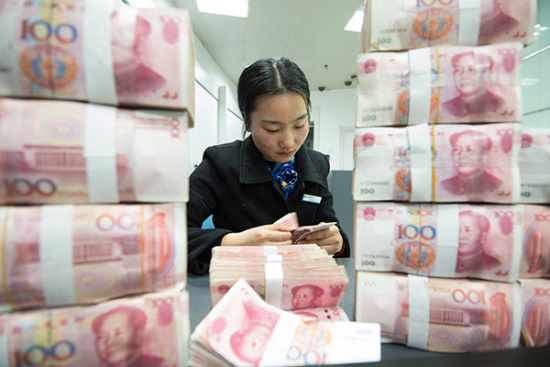
A clerk counts cash at a bank outlet in Hai'an county, Jiangsu province. (Photo/China Daily)
Move sees surge in country's new loans in Jan to 2.9 trillion yuan
China's tightening regulations on bank lending have put more hidden credit back on balance sheets, as the authorities strive to readjust the method of calculating the major money supply indicator to better supervise financial expansion.
The country's yuan-denominated new loans surged to a record high of 2.9 trillion yuan ($460 billion) in January compared with 584.4 billion yuan in December, according to data released by the People's Bank of China on Monday. It was 867 billion yuan more than the same period a year earlier.
But the record figure doesn't mean a credit boom as before, when banks were encouraged to lend money to large investment projects approved by the government to stabilize economic growth.
This time, it reflects off-balance-sheet financing, or the fact that borrowing bypassing banks' regular bookkeeping as "credit" on their balance sheets in order to satisfy the loan-to-deposit standard, has been tamed, especially for tightened entrusted loans, said analysts.
That can be proved by the slowdown in the total social financing growth, which dropped to 11.3 percent in January from 12 percent in December, said Guo Yuwei and Li Miaoxian, researchers at CIB Economic Research and Consulting Co Ltd.
TSF is a broad measure of credit and liquidity in the economy, including off-balance-sheet forms of financing that exist outside the conventional bank lending system.
According to a statement from the central bank released on Monday on its website, the composition of broad money supply, or the M2, has been enlarged since January, adding money-market funds held by non-deposit institutions to the calculation. The institutions also cover non-banking financial companies and non-financial enterprises.
It means a change in the broad money definition and the wealth management products would be absorbed as part of the statistics, to reflect a more precise measure of money supply, said Wang Jian, an analyst with Guosen Securities.
After the adjustment, the total M2 amount has been enlarged by 1.15 trillion yuan to 172.08 trillion yuan, a year-on-year growth of 8.6 percent in January, 0.1 percentage points higher than that before the adjustment and accelerated from 8.2 percent at the end of last year, said the PBOC.
Wen Bin, a researcher with China Minsheng Bank, said that the central bank's earlier targeted easing of the reserve requirement ratio, which injected around 450 billion yuan into the financial market, could support the faster growth of M2 and it will also help maintain sufficient liquidity during the Lunar New Year holiday.
In the first quarter, analysts forecast that bank lending may see a rise compared with the fourth quarter of last year, as the credit demand from the real economy is strong, especially in the manufacturing sector.


















































